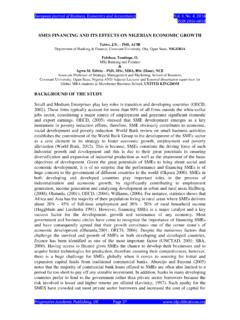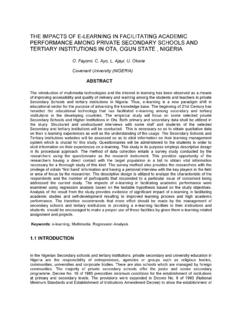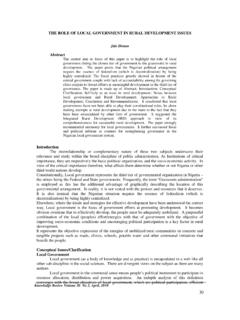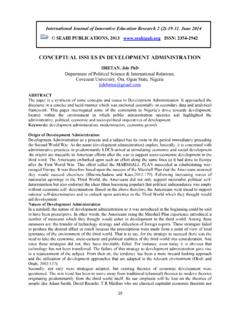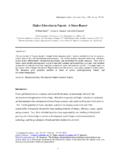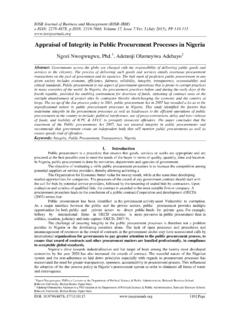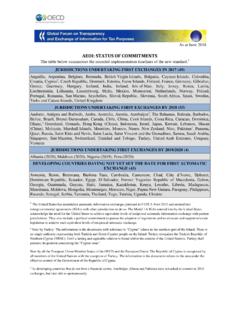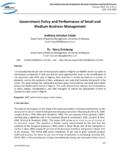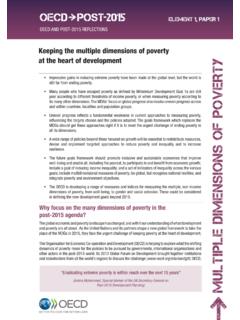Transcription of FINANCING AGRICULTURAL COOPERATIVE …
1 I FINANCING AGRICULTURAL COOPERATIVE SOCIETIES IN nigeria : CHALLENGES AND PROSPECTS BY IKPEFAN, O. A LECTURER, (BANKING & FINANCE) COVENANT UNIVERSITY, OTA, OGUN STATE e-mail Tel 08053013418 . ABSTRACT This paper looked at the challenges and prospects of FINANCING AGRICULTURAL Cooperatives in nigeria . The objective of the study is to find out the contribution of financial institutions to ii AGRICULTURAL COOPERATIVE FINANCING and if there is any significant relationship between the factors inhibiting AGRICULTURAL Cooperatives and Non- AGRICULTURAL Cooperatives. The results of the study confirmed that there is no significant preference in the extension of loans to AGRICULTURAL Cooperatives by financial institutions and that there is a significant relationship in the factors affecting the performance of AGRICULTURAL Cooperatives and Non- AGRICULTURAL COOPERATIVE .
2 The study identified amongst others lack of credit facilities, loan default, lack of basic infrastructure, lack of securities, and technical expertise as the challenges of AGRICULTURAL cooperatives FINANCING in nigeria . Keywords: AGRICULTURAL Cooperatives, Non- AGRICULTURAL Cooperatives, AGRICULTURAL COOPERATIVE FINANCING , Non-Parametric test Statistics, Commodity Exchange, COOPERATIVE Law 1 INTRODUCTION In developing countries, desertification, population pressure, overgrazing, use of dangerous chemicals as fertilizers and pesticides and the destruction of forests are the most important ecological dangers causing and being reinforced by global changes of climate. According to Muenker (1994) assessment, the FAO (Food and AGRICULTURAL Organization) and the World Bank, limits of sustainability of the world ecological system have been reached or even passed. He went further to support these facts with the following points: Tropical forests are reduced by 11 million ha per annum; the loss of humus layer on AGRICULTURAL land exceeds regeneration by 26,000 million tons per annum; wrong farming methods turn 6 million hectares- per annum into new desert; thousands of lakes are biologically dead and many more are dying; the level of ground water is falling in large parts of Africa, China, India, North America; some 1000 species of plant and animal life are extinct every year, within the next 20 years one fifth of all known species would have disappeared; the global climate, the temperature will rise by to degrees Celsius until the year 2030; the sea level will rise by to meters by the year 2100.
3 Before the oil boom, agriculture and its various COOPERATIVE facets have done nigeria a lot of good by providing the foreign exchange and the wherewithal needed by the nation to provide the infrastructure and social needs of the people. It is unfortunate that the hen that laid the golden egg of yesteryears is now neglected. The word AGRICULTURAL cooperatives/ AGRICULTURAL COOPERATIVE societies are used interchangeably. The brain behind COOPERATIVE movement lies with Rocdale pioneers in guiding principle was self help. But the boundaries has been overshadowed by COOPERATIVE farmers in developed countries and they have made significant contribution to their various economies cooperatives have been formed for production of food and cash crops. Of course, cooperatives like any other enterprise will need funds to finance their operations. Whether or not innovations in cooperatives can be undertaken and financed, will largely depend on the capability of the leadership and management to mobilize members resources.
4 2 In developing countries, appropriate technologies have been developed for use of solar energy. For example, to cook food without firewood, to catch rainwater to be used during the droughts, to introduce sophisticated irrigation scheme, new high-yield varieties of plants, however, all these known technologies are not reaching the masses of the population. In developing countries, mass poverty, high unemployment, inflation, unfavorable terms of trade for export crops and the burden of foreign debts constitute a bleak picture for AGRICULTURAL COOPERATIVE . Nigerian cooperatives had their genesis in the wake of the world depression of major interest of the colonial masters in introducing cooperatives at that time was AGRICULTURAL cooperatives. In developing countries, the joint family social security network, which, however starts to show strains, especially where poverty, scarcity of land and political unrest forces people to migrate, leaving children, women and old people behind.
5 Many large cooperatives have perished despite growth, through overstretching of their resources and capabilities. Attempts have been made to adjust the COOPERATIVE model to needs of survival of COOPERATIVE law close to the company model. This would mean opening new ways of raising capital from members and non-members and ultimately from the capital market. For example, making COOPERATIVE shares more attractive for investors, giving board managers more autonomy to manage the COOPERATIVE enterprise without too much interference from the membership in general meeting or their elected representatives would make individuals and institutions to patronize AGRICULTURAL Cooperatives. Globally, attempts have been made to promote and finance AGRICULTURAL cooperatives. According to the Federation of Danish Cooperatives, ( edu,) AGRICULTURAL cooperatives have decided in the past to organize the refining of their products in a corporation and have been able to obtain capital from banks, insurance companies and pension funds.
6 They keep majority of the stocks of corporation but the risk is shared with others. The two most export oriented sectors; pigs and milk are owned by COOPERATIVE enterprises. AGRICULTURAL cooperatives constitute 30 percent of Danish export because they are adequately financed and they employ consultants to counsel their members. The International labour Conference (ILO), 89th session, June 2001 opined that a new development in the AGRICULTURAL sector which emphasizes on vertical integration from 3 primary producer to final consumer. In the United States the so called New Generation Farmers Cooperatives (NGFC) have given farmers larger earnings by selling processed products instead of raw products. This NGFC model has substantially impacted on the hitherto neglected rural areas. NGFC model has since spread from North Dakota and Minnesota, to Wisconsin, California, South Dakota, Iowa and Canada. According to ILO (2001) in Japan, AGRICULTURAL marketing cooperatives handle 95 percent of rice while in Finland cooperatives are responsible for 79 percent of AGRICULTURAL and 31 percent of forestry production.
7 In Italy, the Government has favored the creation of COOPERATIVE funds to finance the initial establishment of new cooperatives In the Czech Republic, members of AGRICULTURAL cooperatives have been able to claim ownership of land and resume private farming since 1989 and this has led to most AGRICULTURAL collectives transforming into companies of shareholding members. The International labour conference also reported that the number of members of financial cooperatives increased by about 350 percent from 1960 to the end of 1997, the World Council of Credit Unions (WOCCU) alone comprised 34,839 credit unions and 95,926,879 members in 28 Africa, 11 Asian, 3 Pacific, 13 Caribbean, 16 Central and South America and 5 North American and European countries with more than million members in North America alone. The ILO (2001) also posited that: In Russia the Government was able to reorganize Sowchos (state farms) into shareholding companies and Kolchos (collective farms) into real productive cooperatives.
8 But in Zimbabwe, AGRICULTURAL cooperatives have suffered severely from increase input prices, transport costs and unreliable access to credit. In India 43 percent of AGRICULTURAL credit comes from saving and credit cooperatives. In Latin America, some regional federations have successfully taken on operational functions, permitting the transfer of capital between national savings and loan systems, thereby increasing their finances. Some specialized local Non-Governmental Organisations (NGO) s are now filling the vacuum in the field of COOPERATIVE promotion at the grassroots level and community organizations in developing countries. In India, the Sad guru water and Development foundation in Gujarat has assisted tribal groups in the recent years to establish more than 200 primary cooperatives to generate employment income. 4 According to Hoyt (1996) the previous restrictions on dividends to members of cooperatives did not encourage members to invest beyond the required amounts.
9 This limitation was lifted by International COOPERATIVE Association (ICA) in 1995 to compensate capital and labour fairly. From the ILO (2001) report, in the United States more than one thousand productive cooperatives employed about one hundred thousand workers and twelve million salaried staff The research department of the Central Bank of Nigerian (1999) reported that over 70 percent of the former Nigerian AGRICULTURAL COOPERATIVE Bank operations are directed to large-scale AGRICULTURAL organization. In spite of this, there is no visible contribution from this sub- sector. Obiako (1985) identified some of the problems of AGRICULTURAL credit to non-existence of insurance, high interest charges on loans making the cost of borrowing higher than normal. Grower (1986) cited in CBN research report (1999) stated that the benefit of credit scheme enhances AGRICULTURAL output. According to Beghin, Bureau and Park (2003) the Republic of Korea has supported its AGRICULTURAL sector at a relatively high level compared to that of other member countries of the Organization for Economic Cooperation and Development (OECD).
10 Bature (2003) in her scholarly contribution identifies the principal problems facing AGRICULTURAL FINANCING in nigeria to include lack of credit facilities, lack of technological know-how, lack of basic infrastructures and lack of securities. Okuneye (2002) opined that interest rate should be worked out between government at various levels, the financial institutions and the apex bodies of the farmers including cooperatives. Okongwu (1991) opined that to boost agriculture, bank interest on loans to AGRICULTURAL enterprises should enjoy 100percent tax exemption. Balogun (1993) in his contribution stated that agriculture has important linkages and interrelationships with the rest of the economy as it provides important raw material for industries, food and fibre for the populace. Ogunwale e tal (1992) argue that high cost of administering fund, substantial payment of annual taxes preclude banks from extending facilities in the development of agronomic and pest/diseases control measures for the attainment of optimum yield and quality of crops and livestock, and preservation of soil quality.

